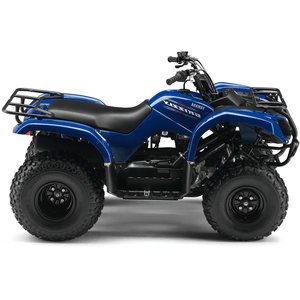Yamaha YFM 125 Grizzly (2004-2012): The Youthful Workhorse That Grew a Cult Following
Introduction
The Yamaha YFM 125 Grizzly isn’t just an ATV—it’s a rite of passage. From 2004 to 2012, this compact, air-cooled quad carved out a reputation as the go-to machine for young riders and practical users who needed reliability without complexity. Sitting astride a 2021 example (still in pristine condition thanks to its previous owner), I quickly understood why this model remains a favorite in used markets and trailhead parking lots. It’s not about brute force or flashy tech; it’s about simplicity done right. Whether you’re navigating muddy backwoods, hauling gear to a hunting spot, or teaching a teenager throttle control, the Grizzly 125 feels like an old friend—one that won’t let you down.
Design & Build Quality: Function Over Flair, But With Charm
The Grizzly 125’s design screams “no-nonsense.” Its compact dimensions—1,699 mm (66.9 inches) long and 991 mm (39 inches) wide—make it agile in tight trails, while the 685 mm (27-inch) seat height ensures accessibility for riders as young as 12 (under adult supervision, of course). The steel frame is stout but not overbuilt, keeping the curb weight at 152 kg (335 lbs)—light enough to maneuver, heavy enough to feel planted.
Yamaha offered this generation in vibrant hues like Steel Blue, Hunter Green, and Black Metallic, though sun-faded examples often sport a patina of mud and scratches earned through honest work. The body panels are durable but flexible, absorbing minor impacts without cracking. Dual 30W Krypton headlights cut through dusk trails adequately, though many owners upgrade to LED pods for serious night riding.
The digital dash? Forget it. You get analog basics—a fuel gauge and speedometer—which aligns with the Grizzly’s ethos: less to break, more to enjoy. Storage is minimal, but aftermarket racks (available at MOTOPARTS.store) easily bolt onto the rear cargo hooks.
Engine & Performance: Modest Power, Maximum Reliability
At the heart of the Grizzly 125 lies a 124cc (7.57 cubic-inch) SOHC single-cylinder engine. With 9 PS (6.6 kW) on tap, it won’t win drag races, but the torquey low-end delivery is perfect for chugging up hills or towing small trailers. The Mikuni VM18SH1 carburetor is a champ—once warmed up, throttle response is crisp, though cold starts occasionally require patience. Yamaha’s V-belt automatic transmission eliminates gear-shifting hassles, making it ideal for beginners.
On a mixed trail ride, the Grizzly tops out around 55 km/h (34 mph)—enough to feel brisk but not intimidating. The air-cooled engine never protested, even after an hour of stop-and-go riding in 25°C (77°F) heat. Fuel economy is stellar: expect 30-35 km/l (70-82 mpg) from the 7.5-liter (2-gallon) tank.
Key Numbers:
- Compression Ratio: 9.0:1 (forgiving on regular fuel)
- Idle RPM: 1,650–1,750 (smooth and steady)
- Oil Capacity: 1.25L (1.32 quarts) with filter
On-Road & Off-Road Handling: Where the Grizzly Earns Its Name
The Grizzly’s 2WD system keeps things simple. You won’t tackle deep mud pits, but for light trails, rocky paths, and snowy driveways, it’s more than capable. The independent front suspension (70 mm/2.8 inches of travel) and rear swingarm (80 mm/3.2 inches) absorb smaller bumps comfortably, though bigger hits will jolt your spine.
Tire sizes varied slightly over the years, but most models rolled on 20/7-8 fronts and 22/10-8 rears—aggressive enough for dirt but tame on gravel roads. Drum brakes at the rear (and sometimes front) require a firm pull, but the lightweight chassis helps with stopping. Ground clearance of 145 mm (5.7 inches) skirts over roots and ruts, though skid plates are a wise investment for rocky terrain.
Competition: How the Grizzly Stacks Up
The youth ATV segment has always been competitive. Here’s how the Grizzly 125 fared against rivals:
- Honda TRX90/TRX250: Honda’s offerings were smoother and slightly more refined, but the Grizzly countered with a taller seat height and better low-end grunt.
- Kawasaki KFX90: Sportier and quicker-revving, the KFX appealed to thrill-seekers but lacked the Grizzly’s towing capacity and durability.
- Suzuki LT-A100: Lighter and cheaper, the LT-A100 felt flimsier in rough terrain and struggled with uphill climbs.
The Grizzly’s ace? Balance. It wasn’t the best at anything but excelled at being good enough at everything—a jack-of-all-trades for rural lifestyles.
Maintenance: Keep It Simple, Keep It Running
The Grizzly 125 thrives on neglect… to a point. Here’s how to ensure yours outlives its next owner:
- Oil Changes: Use SAE 10W-40 (API SG+). Swap every 100 hours or annually—whichever comes first.
- Valve Adjustments: Check every 500 km (310 miles):
- Intake: 0.08–0.12 mm (0.003–0.005 inches)
- Exhaust: 0.10–0.14 mm (0.004–0.006 inches)
- Chain Care: The O-ring chain (74 links, 12/32 sprockets) needs regular cleaning and lubrication. Replace if sag exceeds 25–35 mm (1–1.4 inches).
- Carb TLC: Clean the Mikuni carb annually. Set the air screw to 2.5 turns out as a baseline.
- Tire Pressure:
- Front: 0.17–0.23 bar (2.5–3.3 psi)
- Rear: 0.22–0.28 bar (3.2–4.1 psi)
Pro Tip: Upgrade to an NGK CR7HIX iridium spark plug for colder climates—it ignites more reliably than the stock CR7HSA.
MOTOPARTS.store stocks everything from OEM-style air filters to heavy-duty skid plates tailored for this generation.
Conclusion: A Legacy of Dirt and Dependability
The Yamaha Grizzly 125 isn’t glamorous, but it’s the ATV equivalent of a trusty pocketknife—unpretentious and always useful. Its 2004–2012 run refined the recipe without overcomplicating it, creating a machine that’s as at home on a farm as it is on a motocross practice track. While newer quads boast fuel injection and touchscreen dashboards, the Grizzly reminds us that sometimes, all you need is a carburetor, a solid frame, and a willingness to get dirty.
For owners looking to extend their Grizzly’s lifespan, MOTOPARTS.store offers upgrades and replacements that honor its simplicity—because classics deserve to stay on the trail.



















